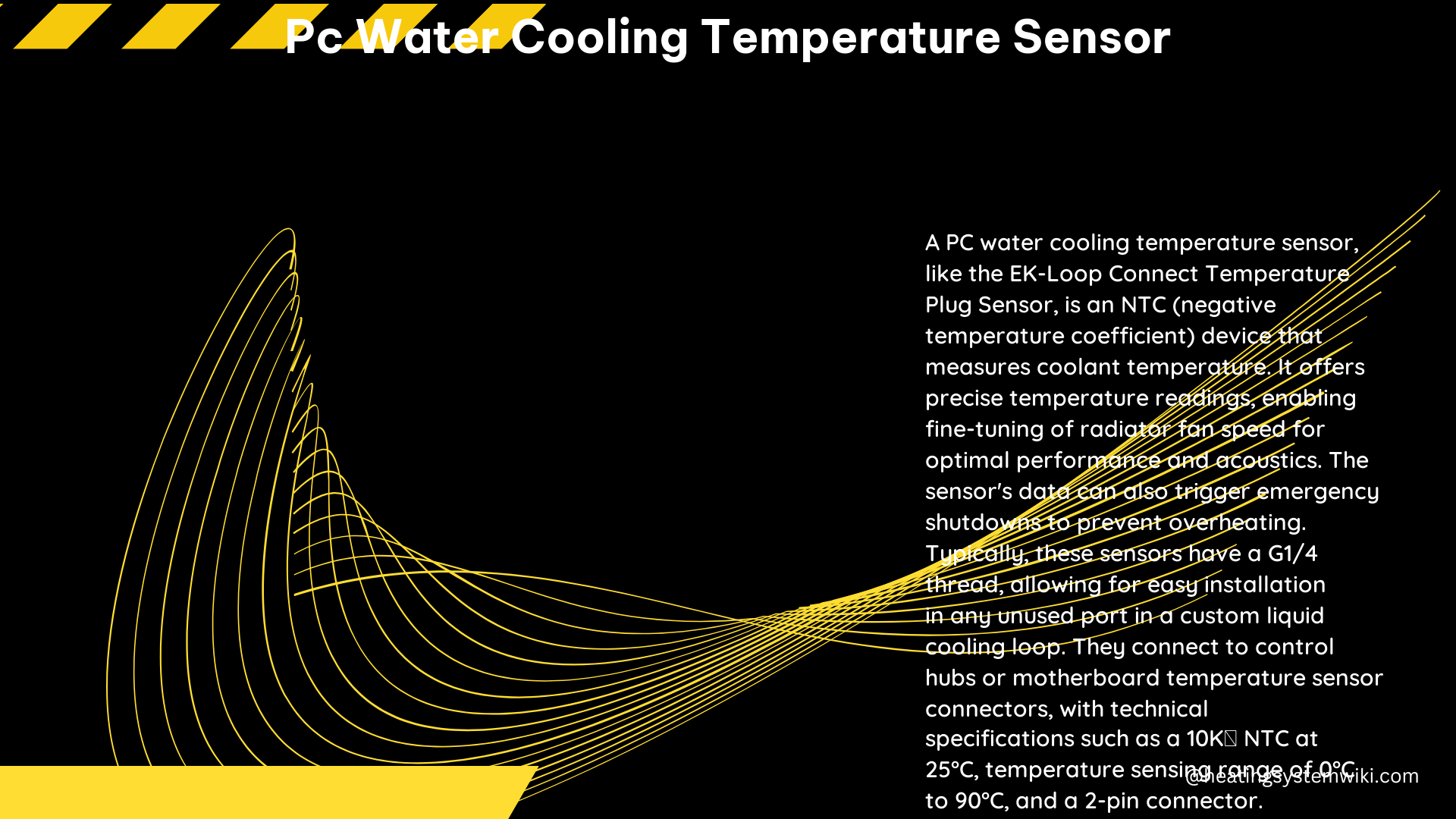A PC water cooling temperature sensor is a crucial component in a water-cooled system, providing precise monitoring of the coolant temperature to ensure optimal cooling performance and component protection. This comprehensive guide delves into the intricacies of PC water cooling temperature sensors, covering their importance, installation, and technical specifications.
Understanding the Role of Temperature Sensors in Water Cooling
Water cooling systems are designed to efficiently dissipate heat generated by high-performance computer components, such as the CPU and GPU. The temperature sensor plays a vital role in this process by continuously monitoring the coolant temperature, allowing users to fine-tune the system’s cooling performance and maintain safe operating temperatures.
By monitoring the coolant temperature, users can:
- Optimize Cooling Efficiency: The temperature sensor data can be used to adjust the speed of the system’s cooling fans, ensuring that the radiators and other cooling components operate at their optimal efficiency.
- Prevent Overheating: Continuous temperature monitoring helps identify any potential issues, such as a malfunctioning pump or a blockage in the cooling loop, allowing users to take immediate action to prevent component damage due to overheating.
- Maintain Stable Performance: Keeping the system’s components within their recommended temperature range helps maintain stable and reliable performance, preventing throttling or unexpected shutdowns.
Sensor Placement and Positioning

The placement of the temperature sensor within the water cooling loop is not as critical as one might think, as the coolant temperature tends to equalize throughout the system. However, some users prefer to install the sensor in specific locations for optimal monitoring:
- Between Radiator and Pump Inlet: Positioning the sensor between the radiator and the pump inlet can provide a direct measurement of the coolant temperature as it enters the system, giving a clear indication of the cooling performance.
- At the Reservoir Intake: Placing the sensor at the intake of the reservoir can also provide a reliable temperature reading, as the coolant is well-mixed at this point.
Regardless of the specific location, the temperature sensor should be installed in a port that is in direct contact with the circulating coolant to ensure accurate measurements.
Types of Temperature Sensors
There are various types of temperature sensors available for PC water cooling systems, each with its own unique features and specifications. Some of the most common types include:
- Negative Temperature Coefficient (NTC) Sensors: NTC sensors are the most widely used type in water cooling applications. They feature a resistance that decreases as the temperature increases, providing a linear and accurate temperature measurement.
- Positive Temperature Coefficient (PTC) Sensors: PTC sensors have a resistance that increases as the temperature rises, offering a different approach to temperature monitoring.
- Thermistor Sensors: Thermistors are a type of resistor that changes resistance in response to temperature changes, providing a reliable and cost-effective temperature measurement solution.
- Thermocouple Sensors: Thermocouple sensors use the thermoelectric effect to generate a voltage that is proportional to the temperature, offering a wide measurement range and high accuracy.
The choice of sensor type often depends on the specific requirements of the water cooling system, such as the desired accuracy, measurement range, and compatibility with the system’s control hardware.
Technical Specifications of PC Water Cooling Temperature Sensors
When selecting a temperature sensor for a PC water cooling system, it’s important to consider the following technical specifications:
| Specification | Description |
|---|---|
| Sensor Type | The type of temperature sensor, such as NTC, PTC, or thermistor. |
| Resistance | The resistance of the sensor at a specific temperature, typically 25°C. |
| Temperature Range | The minimum and maximum temperatures the sensor can accurately measure. |
| Connector Type | The type of connector used to interface the sensor with the system’s control hardware, such as a 2-pin header. |
| Cable Length | The length of the sensor’s cable, which determines the placement flexibility. |
| Material and Finish | The materials used in the sensor’s construction, such as brass or nickel, and the surface finish. |
| Dimensions | The physical size of the sensor, including the outer diameter and installed height. |
| Compatibility | The sensor’s compatibility with the system’s cooling components and coolant type. |
One example of a high-quality PC water cooling temperature sensor is the EK-Loop Connect – Temperature Plug Sensor. This sensor features a CNC-machined brass body with a nickel finish, a G1/4 thread for easy installation, and an NTC 10kΩ at 25°C temperature probe. It has a temperature sensing range of 0°C to 90°C and can be connected to the EK-Loop Connect control hub or a motherboard temperature sensor connector.
Coolant Compatibility and Installation Considerations
When using a temperature sensor in a PC water cooling system, it’s crucial to consider the compatibility of the sensor with the coolant being used. Some coolants, such as those containing aluminum components, can potentially damage the sensor’s nickel plating or other materials. It’s recommended to use specifically engineered coolants that contain corrosion, scale, and biological inhibitors to ensure the longevity and performance of the temperature sensor.
Additionally, the sensor should be installed in a port that is in direct contact with the circulating coolant. Ports that are not in the main cooling loop may provide inaccurate temperature readings, as the sensor will not be measuring the true coolant temperature.
Conclusion
A PC water cooling temperature sensor is an essential component for monitoring the performance and health of a water-cooled system. By understanding the role of temperature sensors, their placement, and the technical specifications to consider, users can optimize their cooling systems for maximum efficiency, stability, and component protection. With the right temperature sensor and proper installation, water-cooled PCs can operate at their peak performance while maintaining safe operating temperatures.
